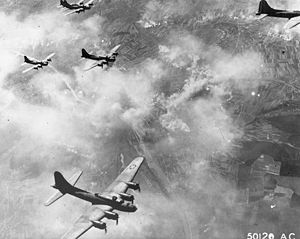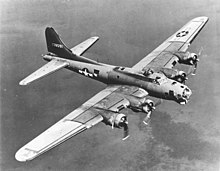Operation Double Strike

Operation Double Strike was the code name for an American air strike operation during World War II . It took place on August 17, 1943. The targets were Regensburg and Schweinfurt . For the United States Army Air Forces (USAAF) it was one of the most lossy operations ever.
The plan
On August 17, 1942, the 8th US Air Force flew its first mission in Europe. Exactly a year later, it launched its most ambitious attack to date. For the first time, American heavy bomber units were supposed to bomb two targets deep in the enemy rear at the same time.
The first destination was the Messerschmitt factory in Regensburg -Prüfening, where, among other things, the Bf 109 fighter aircraft was produced, but also sea mines and torpedo hulls, as well as light metal parts for submarine towers. The second association was supposed to attack Schweinfurt , which was the center of the German ball bearing industry .
Both destinations were in Bavaria and thus in the south of the Reich , which meant a very long flight to and from England . The range of the American fighter planes of that time was still too limited to protect the bombers all the way. In order to minimize its own losses, the USAAF therefore resorted to two lists of war. On the one hand, the Schweinfurt Association should only start shortly after the one intended for Regensburg. This would have the German Luftwaffe much more difficult to fight these bombers as their own fighter planes after the first attack to refuel and rearm their air bases would have to return. The first wave of US bombers was not supposed to fly back to England after the bombing of the Messerschmitt works in Regensburg, but instead turned south and landed in North Africa. So they should avoid the German hunters who ambushed them along the alleged return flight route.
The 3rd Air Division under the leadership of Colonel Curtis E. LeMay was to carry out the attack on Regensburg with three so-called Provisional Combat Bombardment Wings (401st, 402nd and 403rd PCBW). These three battle groups in squadron strength consisted of seven bomber groups with a total of 146 Boeing B-17 bombers . Due to the long flight route to North Africa, these machines were equipped with special long-range tanks, which were nicknamed Tokyo Tank .
The 1st Air Division under General Robert B. Williams was planned for Schweinfurt with a total of three PCBWs (101st, 102nd and 103rd PCBW) and a composite group - a total of twelve bomber groups with 230 aircraft.
Furthermore, numerous fighters, fighter-bombers and light bombers were involved in the operation , which were to provide escort to the B-17 and to fly diversionary attacks on targets in France and the Netherlands .
Instead of Regensburg, the planned alternative and secondary goals were
as well as in place of Schweinfurt
- a mechanical engineering factory in Frankfurt
- a marshalling yard in Aachen and
- an instrument factory in Bonn .
The attack on Regensburg
The 146 bombers destined for the Regensburg target took off from their bases in England at around 7 a.m. local time. Until reaching the German western border, the mission went without any major problems.
However, after the P-47 Thunderbolt escort fighters had to turn off because of their limited range, the bombers were exposed to attacks by the German air force almost defenseless . This used not only conventional fighters, but also, for the first time, large-caliber air-to-air missiles that had been developed from smoke-throwing projectiles. Some German machines even dropped bombs with time fuses into the American unit from above .
At 12:24 p.m. local time, an air alarm was given in Regensburg . At 12:31 p.m., the industrial protection team with six Bf 109-G6 machines started from the Messerschmitt factory airport. One of these machines shot down a B-17 near Hemau . A total of twelve B-17s of the US unit destined for Regensburg were shot down by the Germans before reaching the target; seven planes had previously had to return to England due to technical problems.
The first bombs fell at 12:42 p.m. A total of 971 explosive bombs of 500 pounds (227 kg) each and 448 incendiary bombs of 112 kg each were dropped. Around 70 percent of these hit the factory premises and the airfield. The shelling by German flak was only weak and imprecise (some batteries could only fire barrages because all target devices were located at a neighboring battery for checking). After the attack, the unit turned south as planned. At 2:13 p.m. the all-clear was given in Regensburg .
A total of 24 B-17 bombers with a crew of around 200 were lost in the attack on Regensburg. About fifty machines were more or less badly damaged. Two bombers landed in Switzerland. The 100th Bombardment Group suffered the greatest losses with 9 of 21 aircraft in use. Her losses were also very high in later attacks, which earned her the nickname Bloody Hundredth .
On the German side, around 400 people were killed, including 91 apprentices and numerous mostly Soviet prisoners of war. Most were buried in mass graves in the Upper Catholic Cemetery. A few residential buildings were damaged or destroyed, but the damage to civilian buildings remained minimal, as the plant was still far outside the city at the time. The Brothers of Mercy hospital, located right next to the airfield, was hardly affected. In the following three weeks, no aircraft could be produced in Regensburg. In December the production quota of July was reached again, the Allies had expected a failure of nine months. The final assembly of the Bf-109 fighters was largely relocated to the nearby plant in Obertraubling after the air raid . In addition, concentration camp inmates were increasingly used in various concentration camps for the production of aircraft parts; for example in the Flossenbürg concentration camp .
The attack on Schweinfurt
The association planned for the Schweinfurt destination should actually start ten minutes after the first one. Due to thick fog at the airports of the second attack wave, the departure was delayed by three hours - time enough for the Luftwaffe fighters to prepare for another battle. The 1st Air Division was massively attacked on the way there. The heaviest aerial battles of the day, however, occurred during the return flight over West Germany and Belgium . A total of 36 of the 230 B-17 machines in this association were lost; 122 were damaged, 27 of them seriously.
183 B-17s reached Schweinfurt and dropped 719 high-explosive bombs of 500 pounds (227 kg) each, 235 high-explosive bombs of 1,000 pounds (454 kg) and 1,017 incendiary bombs of 112 kg each. The ball bearing industry in Schweinfurt was hit hard. However, the German Reich Minister for Armaments and Ammunition Albert Speer succeeded in largely compensating for the effects on the German armaments industry - also through imports from Switzerland and Sweden .
Two months after the Double Strike operation , the USAAF attacked Schweinfurt again on October 14, 1943. 77 Flying Fortresses were shot down and another 121 were hit so badly that they could no longer be put into service. This day later went down in American Air Force history as Black Thursday .
Conclusion
A total of 60 flying fortresses and some fighter planes were shot down by the Germans at the Double Strike company ; about 600 Americans were killed. In addition, there were 176 more or less badly damaged bombers, some of which reached their airport again with difficulty and then had to be scrapped.
According to the USAAF, of the 60 bombers that crashed:
- 41 shot down by German fighters
- 4 went in accidents and
- 14 lost for reasons unknown.
- 1 aircraft was shot down by the flak.
Of the 176 damaged machines:
- 76 to the account of the flak
- 57 on that of the hunter and
- 43 were damaged for other reasons.
The German anti-aircraft gun was able to damage numerous bombers, but actually crash very few.
The Air Force lost 25 of a total of around 300 (mostly single-engine) aircraft and some crew members (although the USAAF reported much higher losses).
As early as August 1, 1943, during Operation Tidal Wave against the oil fields in Ploieşti, Romania, 177 heavy four-engine B-24 Liberator 53 bombers were shot down and 55 were badly damaged. This, as well as Double Strike and the already mentioned October attack on Schweinfurt, prompted the Americans to refrain from attacking deep into enemy territory for the time being. Only with the introduction of the long-range fighter P-51 Mustang could such operations be considered again.
See also
literature
- Ronald H. Bailey: The Air War in Europe , Time Life, ISBN 90-6182-432-X .
- Friedhelm Golücke : Air war against ball bearings: the American air raid of October 14, 1943 on Schweinfurt as a model of "Strategic Bombing". Dissertation University of Würzburg, 1974.
- Friedhelm Golücke: Schweinfurt and the strategic aerial warfare 1943: The attack by the US Air Force on October 14, 1943 against the Schweinfurt ball bearing industry . Verlag Ferdinand Schöningh, Paderborn 1980, ISBN 3-506-77446-8 .
- Eduard Jablonski: Double strike against Regensburg and Schweinfurt , Motorbuch Verlag, Stuttgart 1975, ISBN 3-87943-401-8 .
- Martin Middlebrook : The Schweinfurt-Regensburg Mission , Cassell, London 2000, ISBN 978-0-304-35344-6 .
- Uwe Müller (Ed.): Schweinfurt in the air war 1943–1945 . Publications of the Schweinfurt City Archives, No. 27, Schweinfurt 2013, ISBN 978-3-926896-32-2
- Richard Overy : The Bombing War: Europe, 1939-1945 , Penguin, 2014, ISBN 978-0-14-100321-4 .
- Janusz Piekałkiewicz : Air War 1939–1945 , Bechtermünz Verlag, ISBN 3-8289-0303-7 .
- Peter Schmoll : Air attack - Regensburg and the Messerschmitt works in the cross hairs , book publisher of the Mittelbayerische Zeitung, Regensburg 1995, ISBN 3-927529-12-5 .
- Peter Schmoll: The Messerschmitt works in World War II , Mittelbayerische Druck- und Verlags-GmbH, Regensburg 1998, ISBN 3-931904-38-5 .
- Peter Schmoll: Regensburg - The catastrophe of August 17, 1943 , MZ Buchverlag, Regenstauf 2018, ISBN 978-3-86646-369-1 .
- W. Raymond Wood: Or Go Down in Flame. A Navigator's Death over Schweinfurt , Casemate Publishers, Havertown / Oxford 1993, ISBN 978-1-61200-177-7
Web links
Individual evidence
- ↑ USAAF Mission Report Oct. 14, 43
- ↑ Schweinfurter Tagblatt of February 22, 1984
- ↑ www.100thbg.com Homepage of the 100TH BOMB GROUP ( Memento of the original from June 24, 2012 in the Internet Archive ) Info: The archive link was inserted automatically and has not yet been checked. Please check the original and archive link according to the instructions and then remove this notice.
- ^ Second Schweinfurt Memorial Association
